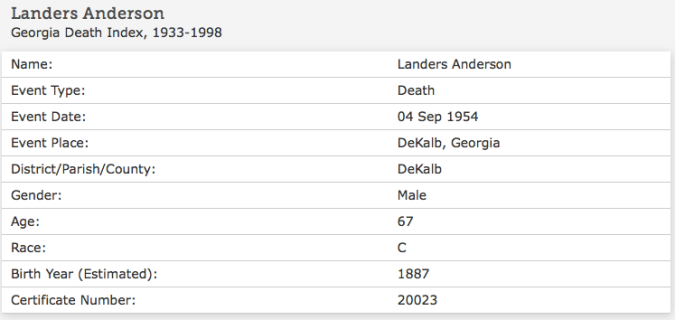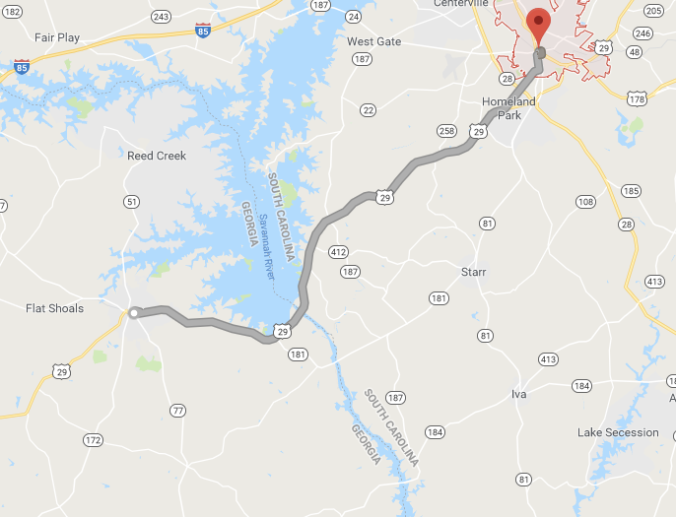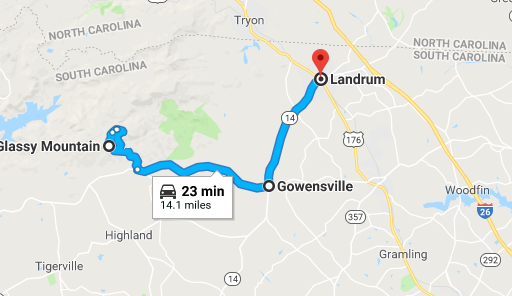I want to tell you about Landrum Anderson, but I can’t. End of blog post. Bye!
Okay but really, in researching the estates of the Candler family for a previous post, I gathered a tremendous amount of information about extended family members, friends, associates, and employees. Thanks to the remarkable efforts of biographers who came before me, the names of several family servants were captured instead of being lost to time. One of those servants was Landrum Anderson.
Who Was Landrum Anderson?
Landrum, known as “Brother Landrum” according to Candler family lore, was the lifelong servant of Asa Candler Jr., owner of Atlanta’s Briarcliff Mansion. Landrum and Asa Jr. met in 1901 in Hartwell, GA, during a brief period when Asa Jr. was sent to North Georgia to run his father’s cotton mill. When Asa Jr. returned to Atlanta in 1906, Brother Landrum came with him. Family lore says it was Asa Jr.’s wife Helen who insisted upon retaining Landrum and allowing him to move south with them.
When Asa Jr. and family moved to Inman Park, Landrum moved with them. When they relocated to Briarcliff Farm, Landrum went with them. When they tore down the farmhouse and built Briarcliff Mansion, Landrum was there. He lived in a small house on the property, rented at a price of $1 per month from his employer. That’s about $15 per month in today’s dollars. And, again according to family lore, Brother Landrum was there until the end, still working for Asa Jr. when Asa died in 1953. He lived only one more year and then passed in 1954.
Landrum is unusually persistent through Asa Jr.’s history. A common element I’ve found in my research into the life of Asa Candler Jr. was that he had few relationships that lasted for very long. He had some friends and servants who stayed with him for years, but no one other than blood relatives stuck by his side like Landrum Anderson.
So who was Landrum Anderson? That’s not an easy question to answer.
The Southern Problem
Brother Landrum was born in the rural South in the post-Civil War era. This was a murky time for records of Black Americans. During the slavery era, slaves were often listed as property belonging to the slave owner, not as people with vital records. The 1870 census was the first record that captured African Americans by name, but is hardly complete. Even if names were captured accurately, they could have been changed and birth names lost to history. Residence locations often changed with few records to follow. Jim Crow laws suppressed voter registration, so those records are spotty for decades. I have very little to go on if I want to trace his history and find his family. I have a name in four census records and family accounts given by Asa Candler Jr.’s grandchildren and great-grandchildren. You’d think that would be enough. It’s not.
Hard Data
In 1910 Landrum Anderson first appears on a census at Asa Jr.’s house in Inman Park. He’s listed as 40 years old, and his occupation is listed as butler. Elsewhere in the record it’s noted that he cannot read or write. He was the only servant on staff at the time. Also listed as a resident is Helen’s brother William, who was granted employment by his brother-in-law as a machinist at the Candler Building. Asa Jr. had a long history of finding jobs for people in his inner circle, or using jobs to pull people into his inner circle. But that’s a story for another day.

1910 Census Record
In 1920 Landrum appears again as a servant, this time living at Briarcliff Farm with the Candler family. Other servants who stayed with the family are also listed. Landrum’s wife Jessy (maid) appears, as do Fanny Upshaw (cook) and Eli Johnson (chauffeur – automobile).
Once again Landrum is noted as 40 years old. If I’ve learned anything from old census records it’s that no one really cared much about capturing the correct vital stats of servants, especially if they weren’t White. Sometimes they didn’t even bother spelling their names right. In the 1920 record all staff are noted as literate, although it would not be unusual for this to be inaccurately reported.

1920 Census Record
Now we get to the 1930 census record. On this one the census taker noted in the margin “West of Briarcliff Rd (Candler Estate)” across several names. Most of the names are listed in labor type jobs and the locations are listed as “private estate.” Through other research I can confirm the Cruz brothers as butler and valet and James Stark as the groundskeeper. My assumption is that all names between the Candlers and Mary Anderson were Briarcliff staff members and their families. This shows how the staff size ballooned once Briarcliff Mansion took shape.
In the 1930 record Landrum is listed as 25 years old. His wife’s name is spelled Jessie instead of Jessy, and their daughter Mary appears, noted as 6 years old. This time it says Landrum cannot read or write. By contrast, it says Jessie did not attend school but can read and write.

1930 Census Record
Then we come to the 1940 census record, the last one available since the 1950 census won’t be made public until 2022. In this one Landrum’s information is different. It’s individualized, less generic. His birthplace is listed as South Carolina. His age is 67 instead of an incremental number ending in 0 or 5. And this time his name is spelled Landers.

1940 Census Record
Jessie’s name is spelled consistently with 1930, but Mary is now Alice, and she’s now listed as Adopted Daughter, age 16. Which makes sense if she was 6 in the previous one, but why did her name and relationship change? Was Landrum her father or not? More importantly, is Landrum’s legal name actually Landers? What the heck happened in 1930? Did someone who didn’t care to know much about the servants rattle off names and fudge the details? Possibly.
In 1954, just a year and a half after the passing of his lifelong employer, Landrum Anderson, or Landers Anderson, as he was officially recorded in the Georgia Death Index, passed away. He spent over 50 years of his life serving the Candler family.

But here, too, we have problems. If he was 67 at the time of his death, why was he listed as 67 in the 1940 census record? Which age was correct? Which of any of the ages were correct? If the 1910 record was correct, he would have been born in 1870, and would have been 84 at the time of his death. If the 1920 record was correct, he would have been born in 1880 and would have been 74 at the time of his death. If the 1930 record was correct he would have been born in 1905, 4 years after he met Asa Candler Jr. I think we can comfortably discard the information in the 1930 record. If the 1940 census was correct he would have been born in 1873 and died at the age of 81.
My concern here is that the information in his death record, his age and spelling of his name, was copied over from the last census. It might be as questionable as any of the other records.
So when I go searching to find out where Landrum came from and whether he had any other family, what do I do? Do I search for Landrum or Landers? Do I search for a birth date of 1870, 1873, 1880 or 1887? What if none of those are correct? Do I search for a birth location of Georgia or South Carolina?
Side Note About Location
I hadn’t questioned where Landrum was from until very recently. I just took it for granted that he met Asa Jr. in Hartwell, GA and all of the documentation I could find said born and raised in Georgia. Then I found the 1940 census where his name was different and the information seemed more specific. His birth place in that one is South Carolina. Have I been wasting my time looking for family in Georgia?
I did a Google search, not really optimistic but sometimes Google gets its little fingers into unexpected sources. I got some hits for the phrase “Landrum Anderson,” like social media profiles for living people of the same name. Then I saw one where the person’s last name was “Landrum” and they were listed as living in a town called “Anderson.” I clicked just out of curiosity. Anderson… South Carolina… Wait a minute…

Hartwell, GA to Anderson, SC. Just 23 miles.
I had made the assumption that Anderson was a surname adopted from his family’s former slaveholders. That’s still plausible, but I realize now that it could have come from the town in which his family lived. If you look for the surname Anderson in Anderson, SC, during the immediate post-Civil War era, you’ll find a large number of African American results. And Anderson wasn’t named for a slaveholder. It was named for a Revolutionary War hero. These people were probably named after the location, not a family.
Then I looked at Anderson’s history. It was a cotton town, a mill town, the first fully electrified town in the South with an electrically powered cotton gin at the mill. In 1901 a flood knocked out the hydroelectric dam that supplied power to the mill, putting it out of commission. The town remained dark until 1902. So in 1901 a hell of a lot of mill workers were put out of work. In 1901 Landrum Anderson met Asa Jr. at Witham Cotton Mill in Hartwell, GA, the next closest mill town.
It’s all speculation, of course. I still can’t find anything to confirm Landrum’s existence prior to the 1910 census. I have nothing for 1900 and the 1890 census was mostly destroyed in a fire. That damn fire made researching Candler residences in Oxford, GA quite a challenge, too.
In another interesting research side-journey, I found that South Carolina has another location-based coincidence for me to ponder. In northern SC, about 60 miles from Anderson, there’s a section of the state comprised of three towns at the foot of the Appalachian Mountains. This section is known historically as the “Dark Corner.” The Dark Corner was the only part of South Carolina that stood with the Union and refused to vote in favor of a measure to reject federal law just prior to the Civil War. Their refusal to be “enlightened” in the eyes of those who wished to fight for state’s rights (code for slavery), landed them with this nickname. One of the Dark Corner towns was Landrum, South Carolina.

The Dark Corner of South Carolina: Glassy Mountain, Gowensville, and Landrum.
Could be a coincidence. Hell, the location of Anderson could be a coincidence. Or it could be confirmation that Landrum’s names were drawn from locations, which would not be terribly unusual at the time. Perhaps Landrum was indeed named Landrum rather than Landers and he was indeed born in South Carolina. At this point I can’t discard or confirm any hunch or lead.
One More Dead End
I have one other tentative lead to explore. A brother, or at least someone I suspect was his brother. Lucy Candler, Asa Jr.’s sister, employed a man named Henry Anderson, and he appeared on the 1930 census under the household of Lucy’s second husband, Henry Heinz.

1930 Census Record for Henry Anderson
Henry is listed with a nice round number, age 50. Black, widowed, illiterate, and of course born and raised in Georgia. Probably no more accurate than any of Landrum’s information, although I do find the detail that he was widowed to be oddly specific. Regardless, simply because of the shared names and the close relationship between their employers, I am considering a possible link between Henry and Landrum. Unfortunately Lucy’s life was a tumultuous one, and her household situation changed frequently enough that her census data shows all different locations, cohabitants and staff on each record. Henry only shows up this one time. I can’t find a shred of information on him otherwise.
Sorry for the Cliffhanger
So this is where I am right now, stuck at an impasse. I still have hope that I’ll stumble upon new information that will lead me to more answers. But for now I have four untraceable people: Landrum or Landers Anderson, his wife Jesse or Jessie, his possible brother Henry, and his daughter Mary or adopted daughter Alice. I can find no birth records, no death records, no marriage records, or anything else apart from what I’ve shared above.
So who was Landrum Anderson? I want to tell you, but I can’t. End of blog post. Bye!
Pingback: Writing a Historical Novel: a Sneak Peek at the Research | Background Radiation